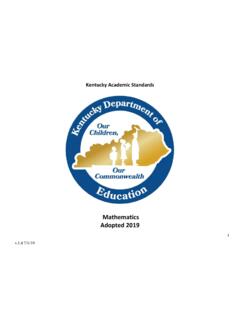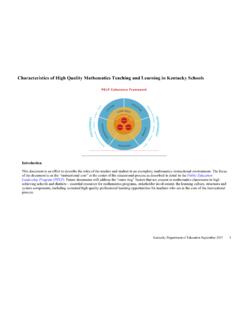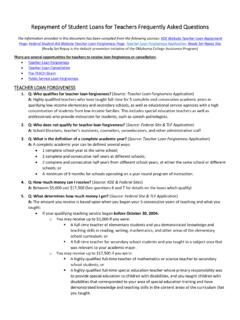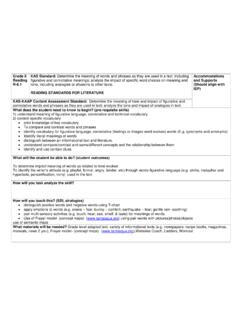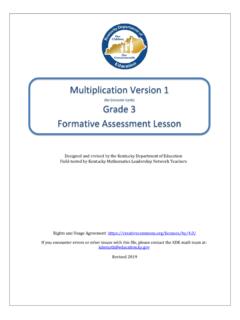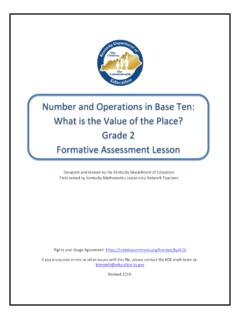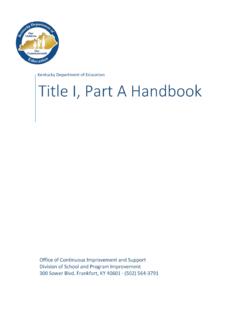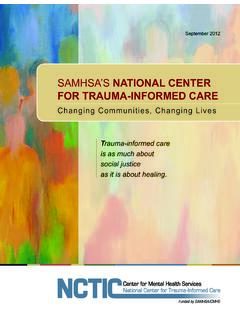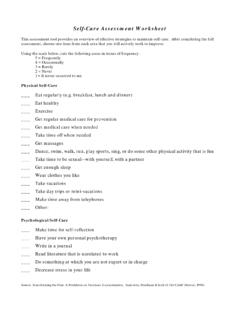Transcription of Trauma-Informed Discipline Response & Behavior System
1 Kentucky Trauma-Informed Toolkit for Schools 1 Trauma-Informed Discipline Response and Behavior System Objective: Schools will be able to develop appropriate Discipline responses and pro-active practices that successfully support students to maintain positive Behavior while recognizing trauma-related causal factors and minimizing opportunities for re-traumatization. Key Concepts: Student Behavior that is challenging may be related to traumatic stress responses. To be effective at maintaining a safe and supportive learning environment for all students and staff, schools should utilize Trauma-Informed disciplinary policies and practices that avoid re-traumatization, reduce potential escalation of difficult Behavior and are embedded in a System of positive Behavior supports. What Do We Mean by Trauma-Informed Discipline Response and Trauma-Informed Behavior System ?
2 Trauma-Informed Discipline responses recognize that when students and staff feel consciously or unconsciously unsafe, the brain-body Response interferes with decision-making and self-regulation. This can cause or exacerbate challenging and undesirable behaviors. Students who have experienced trauma may be particularly likely to experience dysregulated emotions and Behavior in school settings, including poor concentration and difficulty staying on task, disruptive Behavior , and even verbal and physical aggression towards peers or staff. Their automatic self-protective postures may appear to be defensive or aggressive. Common staff responses, including bus drivers, classroom teachers and instructors, counselors and administrators, often escalate the situation, while Trauma-Informed responses seek to contain or calm the situation as well as teach the student to accept responsibility and use more appropriate Behavior .
3 Trauma-Informed Discipline systems recognize these connections between trauma exposure, student Behavior and staff responses and recognizes the value of promotion, prevention and early intervention in the Behavior cycle. Trauma-Informed Discipline systems work at multiple levels to promote positive Behavior supports, prevent Behavior problems through early recognition and early intervention, and provide interventions that support student and staff self-regulation to promote executive functioning for problem-solving and learning. Students are more able to learn right from wrong, develop empathy and compassion, and regulate themselves to prevent and recover from disruptive behaviors. Kentucky Trauma-Informed Toolkit for Schools 2 What Does the Literature Say About Trauma-Informed Discipline in Schools? Reports of reductions in office Behavior referrals, in-school suspension, and out-of-school suspensions after implementation of Trauma-Informed practices that include positive Behavior supports and non-exclusionary disciplinary responses are noted across practice and empirical literature (Baroni, et al.)
4 , 2016; Herrenkohl, et al., 2019; Stevens, 2013a; Stevens 2013b; Stevens, 2012). Evaluation of the Healthy Environments and Response to Trauma in Schools (HEARTS) program reported a 32% decrease in office Discipline referrals the first year, with an 87% decrease after five years. Incidents involving physical aggression diminished as well, 43% in year one, and 86% over the five years, and suspension rates decreased by 95% over five years (Dorado et al, 2016). Trauma-Informed programs also have been found to reduce challenging behaviors in young children (Holmes, et al, 2015). Similarly, research also has noted the limitations and potential hazards of the punishment paradigm as suppressing rather than changing Behavior (Blodgett & Dorado, 2019). Support for the positive impact of Trauma-Informed practices on Behavior also is found in literature on specific programming aligned with Trauma-Informed principles.
5 Both Positive Behavioral Intervention and Supports (PBIS) and Social Emotional Learning (SEL) have been demonstrated to reduce office Discipline referrals (Durlak, et al., 2011; Hoover, 2019). Trauma-Informed programs such as conscious Discipline have demonstrated measurable improvements in school climate, aggression, readiness to learn and at-risk status (Conscious Discipline , 2018). A review of the literature also noted that implementation of restorative justice or restorative practices demonstrated reduced use of exclusionary practices, and decreased incidents of violence (Fronius, et al., 2016). Another body of research examines specific elements of traditional Discipline , including seclusion, physical restraint and zero tolerance. Physical restraint and seclusion are not Trauma-Informed practices, and should be used only in the rare occasion of imminent danger to students or staff consistent with 704 KAR 7:160.
6 The Council for Children with Behavioral Disorders (CCBD) states, there is no research whatsoever indicating that restraint functions as a therapeutic procedure (CCBD, 2020, p. 57) and cautions that seclusion can be overused, misapplied and disproportionately implemented, and used as a mechanism to remove students subjectively deemed undesirable (based on race, ethnicity, Behavior , gender identity, sexual orientation, etc.) by staff (CCBD, 2009). Extensive research has pointed to connections between exclusionary Discipline practices and subsequent risk for dropout, substance abuse, and juvenile justice engagement (Skiba, et al., 2014; Commission on Civil Rights, 2019; Blodgett & Dorado, 2019; Joseph, et al. 2020). Kentucky Trauma-Informed Toolkit for Schools 3 Zero tolerance policies are not conceptually aligned with Trauma-Informed approaches by responding to all circumstances in the exact same way, without regard for underlying causality or effect of systems on Behavior .
7 The American Psychological Association (APA) Zero Tolerance Task Force conducted a thorough review of the literature and concluded zero tolerance has not been shown to improve school climate or school safety .. has not proven an effective means of improving student Behavior , [and] .. zero tolerance policies as applied appear to run counter to our best knowledge of child development (2008). Research on disproportionate application of school Discipline to students who are Black and Brown, as well as those with special education needs also points to the need for a more Trauma-Informed approach . The APA Zero Tolerance Task Force found that zero tolerance policies failed to remove bias and disproportionate application of Discipline to minority students (2008) despite assertions they would promote consistent disciplinary Response . The Commission on Civil Rights 2019 report found students with disabilities are approximately twice as likely to be suspended, and students of color are suspended and expelled more than their White peers, including for the same offenses, and that those punishments are harsher and longer ( Commission on Civil Rights, 2019).
8 Corporal punishment is antithetical to Trauma-Informed principles and values of safety, trust, collaboration, mutuality and equity. Corporal punishment practices themselves also can inflict emotional and physical trauma on students, and re-traumatize students who experienced abuse at home. By seeking to deliberately inflict pain on a student with inherently less power than the adult meting out the punishment, corporal punishment would be classified as assault and battery in most other contexts, and sends the confusing message that physical force and infliction of pain are appropriate means of settling differences or interpersonal conflicts, even when use of physical force is precisely the Behavior being punished. Data reveal that students with identified disabilities, and students who are Black and Brown, experience corporal punishment at higher rates than their White counterparts (Gershoff & Font, 2016; Southern Poverty Law Center, 2019).
9 Research indicates that corporal punishment may contribute to the school-to-prison pipeline by increasing risk for student involvement in the juvenile justice System , and increases risk for perpetration of later dating violence (Temple, Choi, Rueter, Taylor, Madigan & Scott, 2017) and is correlated to later development of mental health and substance use disorders (Afifi, Mota, Dasiewicz, Macmillan & Sareen, 2012). Corporal punishment has not only been correlated to later deleterious Behavior , but fails to correct Behavior in the moment: it fails to engage students in problem-solving based on logical thinking and executive functioning; fails to promote empathy or compassion; reinforces defensive and emotional reactions that more frequently escalate problem behaviors; fails to improve classroom Behavior ; and may exacerbate problem Behavior (Society for Adolescent Medicine, 2003).
10 Schools that allow corporal punishment fail to create the positive Kentucky Trauma-Informed Toolkit for Schools 4 climate and culture critical for strong student outcomes, and actually create a climate that re-traumatizes students who have experienced physical abuse. Corporal punishment can impede learning and school performance by negatively impacting brain development, verbal capacity and executive functioning, such as problem-solving (Durrant & Ensom, 2012). A 2016 letter from Secretary of Education John B. King summarized the concerns about corporal punishment, noting that every major professional organization for providers of child health and behavioral health is opposed to corporal punishment, including the American Academy of Pediatrics (AAP), the American Academy of Child and Adolescent Psychiatry (AACAP), the Society for Adolescent Medicine (SAM), the American Psychological Association (APA), and the National Association of School Psychologists (NASP).
